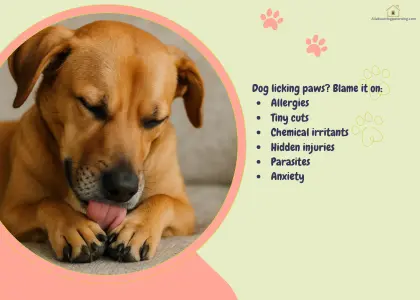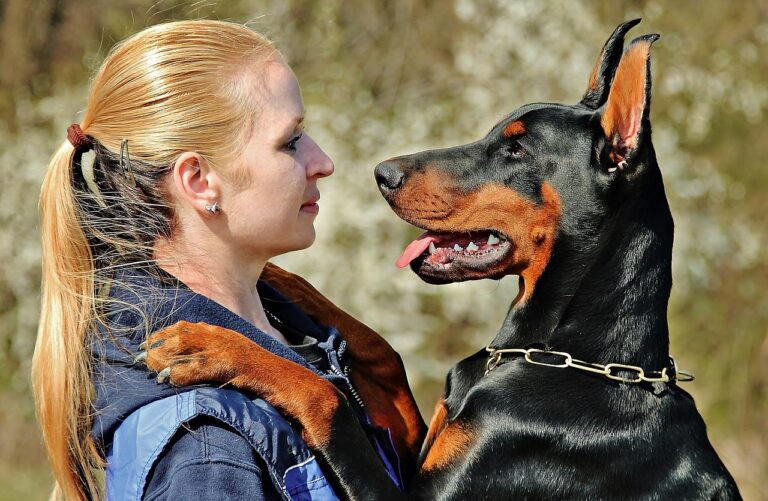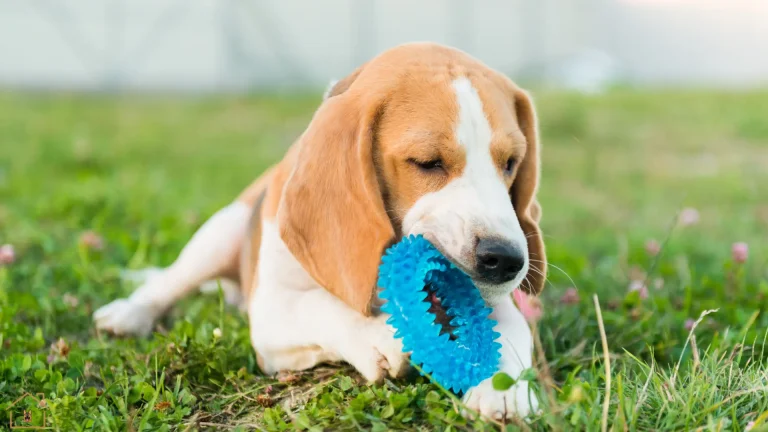Why Does My Dog Lick His Paws So Much? Causes Beyond Allergies
It’s a scene I’ve seen countless times as a pet mom: one paw down, eyes fixed on that spot, and my dog licking his paws, oblivious to the world around him. Through the years, I’ve learned that paw licking causes can range from itchy allergies to tiny cuts, something stuck in your pet’s paws, a chemical irritant, hidden injuries, parasites, flea bites, or even anxiety.
Now, some of these underlying reasons can be harmless, and you can let paw licking slide, in those cases. But others require the right intervention at the right time. How do you discern between the two? I’ve put together this guide on excessive paw licking in dogs to address that exact quandary. Based on my own learnings and insights from veterinarians, I’ll walk you through the common causes, explain what symptoms to watch for, how to soothe and protect paws at home, and when a vet visit is truly needed.
Is Paw Licking in Dogs Normal?
Occasional paw-licking is usually nothing to worry about. Dogs are naturally tidy creatures. In fact, most will take a quick lick after a walk to clean off dirt or grass, much like how we’d wipe our muddy feet. It’s just normal dog grooming behavior.
Dr. Valentina Henao, a veterinarian and medical director at Veterinary Emergency Group (VEG), agrees, “If your dog licks their paws every once in a while, there’s probably nothing to worry about but when it becomes frequent or aggressive, that’s a red flag.”
A key difference between excessive and normal paw licking in dogs is intensity and frequency. Normal grooming is calm and won’t lead to any redness or fur loss. Excessive licking, by contrast, is much more obvious.
For example, a dog may calmly clean a muddy paw then move on, but one that sits and obsessively chews a single foot clearly has an issue. Red or raw patches around the paw pads mean it’s beyond routine grooming.
Common Causes of Paw Licking Beyond Allergies

Other than self-grooming, allergies are a common culprit behind paw licking in dogs. However, when this habit becomes obsessive, it’s usually because of one of the following paw licking causes:
Environmental Irritants
Dogs can step into all kinds of irritating substances. Paw pads are sensitive and so,
- Grass, pollen or lawn chemicals can trigger licking
- Fertilizers, herbicides or pesticides on your lawn may cause immediate itchiness
- Household cleaners or spilled antifreeze on the driveway can burn their skin
For instance, a stroll through a recently-treated yard or across a salted sidewalk can lead to frantic paw-licking. Dr. Henao notes, “Hot pavement or winter chemicals can burn paw pads.” Rinsing or wiping paws after outdoor time helps prevent this kind of environmental paw licking.
Pain or Injury
If your dog is licking their paw excessively and you cannot spot a visible trigger, it could be hurting. Any dog paw injury, be it a small cut, a thorn, or broken nail, will make a dog lick. Outside trauma like walking on hot asphalt, stepping on broken glass or snagging on sharp rocks can blister pads, and your dog may resort to licking as a way to relieve the discomfort.
Pain isn’t always due to injury. Chronic issues like arthritis can lead to aches in a dog’s toe joints. Arthritis in a dog’s toe or ankle often makes them lick their feet for relief. Any dog paw pain, be it from a sting or burn to a stiff joint, will usually turn into a licking hotspot.
Parasites and Infections
Don’t forget the tiny critters and germs. Fleas, ticks and mites can all make a paw unbearably itchy. Dr. Henao explains, “Fleas and ticks are common parasites that can make dogs itch, lick, and bite themselves.” Even mange mites or scabies on the footpads would trigger constant licking.
Likewise, a paw that has already been licked can develop secondary infections. When a paw stays damp with saliva, bacteria or yeast can take hold. Dr Henao adds, “A frequently licked paw stays damp and is more susceptible to bacteria and yeast infections.” If you notice a foul odor, yellow crusts or swelling, your dog may have a yeast or bacterial infection on the paw, which needs veterinary treatment.
Behavioral and emotional causes
Sometimes, compulsive paw-licking in dogs can be a behavioral issue. Dogs can lick to self-soothe. Dogs who are anxious or left alone for long often develop a licking habit out of stress or boredom. Dr Henao notes, “After medical issues are ruled out, problems like stress, separation anxiety or compulsive disorders are common culprits.”
Think of it as a dog version of nail-biting. Boredom paw licking or paw licking due to anxiety can become nearly compulsive. For example, a pup left home alone all day may lick his feet just to relieve monotony, and an anxious dog might do it to calm down. In these cases, upping exercise, mental stimulation or using calming supplements and training can often break the cycle.
Symptoms That Indicate a Problem

Recognizing symptoms early can save a lot of worry. Signs that paw-licking has gone too far are hard to miss. You might see obvious clues like,
- Redness
- Swelling
- Open sores
- Bald patches where fur is rubbed off around the paw
Dr. Henao says, “Watch for bleeding, limping or any discharge. These are red-flag symptoms.” Constant licking can make the fur look damp and stained. My own dog once started with a little redness that turned into a painful infection because he wouldn’t stop licking. A damp, oozing paw pad is a breeding ground for yeast or bacteria. Vets warn such pododermatitis can be painful and lead to infections that are hard to treat. In short, if licking disrupts your dog’s sleep or play, or leaves the pads red, hot or raw, consider it a problem and get it checked. Better to catch a serious issue early than let it fester.
How Vets Diagnose Paw Licking Issues
Veterinary diagnosis is part detective work. At a visit, the vet will perform a thorough dog paw exam: each foot is lifted and inspected thoroughly, from pads to nails and even between the toes, for cuts, foreign objects or subtle injuries. They’ll press on joints to check for hidden pain.
Diagnostic tests often follow. Your vet may take skin scrapings or tape samples to look for mites or fungus, and lab cultures of any discharge to identify bacteria or yeast. Some vets even use a Wood’s lamp or special stains to catch fungal infections. They will also ask about your dog’s routine, diet and environment to hunt for clues.
Dr. Henao emphasizes, “Working with your veterinarian to figure out why your dog is licking their paws is crucial. Finding the real cause quickly is key to treating it effectively.”
Vet-Recommended Solutions Beyond Allergy Treatment

The right dog paw care depends on the underlying cause. Here is what works in different situations:
Treating Irritation or Injuries
For minor irritations or injuries, simple home care often works wonders. Start by rinsing the paw with warm water or pet-safe wipes to remove any dirt, debris or stingers. Dr. Henao warns, “We must remove stingers that can cause allergic reactions.” After cleaning, dry the paw and apply a soothing antiseptic ointment or a dog-safe balm to calm irritated skin. If the pad is raw, wrap it in a light bandage or bootie to keep it clean while it heals.
Also, keep those nails trimmed and hair between toes neat. It prevents many small injuries. Treating a sore paw boils down to basic dog paw care: clean the wound, soothe the irritation, and protect the area. These simple steps often stop a licking flare-up in its tracks.
Addressing Parasites and Infections
If parasites or infections are to blame, targeted treatments are needed.
- For external parasites like fleas or ticks, vets will recommend a strong preventive
- Mange mites or scabies, on the other hand, require prescription dips or medication to eliminate
- For fungal or bacterial infections, medicated foot care comes into play. Vets commonly prescribe special chlorhexidine or antifungal shampoos, sprays and foot soaks
- A diluted chlorhexidine paw soak or an antifungal cream can clear up a yeast infection on a damp paw
- In stubborn cases, oral antibiotics or antifungals help knock out deep infections
Basically, if the paw licking is brought on by parasites or infections, follow your vet’s plan until it clears up.
Managing Stress and Boredom
When stress or boredom are at fault, enrichment and relaxation strategies are essential. Make your dog’s day interesting: long walks, play sessions, puzzle toys or treat-dispensing games all help keep their mind off licking. A tired, mentally stimulated dog is far less likely to chew a paw out of boredom.
For anxious pups, proven calming aids such as pheromone diffusers, natural calming chews or snug anxiety wraps can work wonders. You may also practice counter-conditioning or gentle training for separation anxiety. Behavioral modification, essentially providing more stimulation and reducing stress, should be part of the plan. Every dog is different. Some calm down with extra exercise and attention, others may benefit from vet-recommended supplements or even prescription anti-anxiety medication in severe cases. The goal is to stop compulsive paw licking by taking care of your dog’s emotional needs.
Home Care and Prevention Tips

At home, prevention is truly better than cure. These simple dog paw cleaning tips can stop problems before they start:
- After every walk or romp, wipe your dog’s paws with warm water or pet-safe wipes to remove dirt, pollen or road salt
- Check paws daily for any cuts, splinters or debris
- Keep nails trimmed and the hair between toes short, so there are fewer hiding spots for grass awns or ticks
- Provide chew toys or puzzle feeders so your dog isn’t licking out of boredom
- Before hot or icy weather, apply a dog-safe paw wax or a dab of coconut oil to protect pads
- Use only pet-friendly floor cleaners and clean up spills immediately
- After baths or rainy walks, dry the paws completely to prevent yeast growth
- Feed a balanced diet rich in Omega-3s to support overall skin health, including the paws
All these healthy dog paws care steps work well when practiced together. Routine paw cleaning, nail care and a paw-friendly environment are your best paw licking prevention.
When to See a Vet Urgently
If paw licking crosses into real trouble, it’s time for the vet. Any bleeding, open wound or deep crack is an emergency. Dr. Henao advises getting help if you see any bleeding, limping or discharge. A swollen paw is a warning sign too, as swelling can cut off circulation and become very painful. Foul odors or discharge mean infection, which needs prompt treatment. If your dog licks so much he won’t sleep or refuses to bear weight on a paw, it should prompt an urgent vet visit.
Final Takeaway
Chronic paw-licking is a warning sign that something’s not right. Focusing on dog paw health with regular cleaning, safe walking practices and foot care is the best approach. A little routine attention usually stops problems before they start, so you rarely have to scramble to stop dog licking paws with drastic measures. Remember, a happy, healthy dog won’t obsess over an itch. Dr. Henao advises, “It’s important to work with your veterinarian to figure out why your dog is licking their paws so the cause can be addressed.” With simple preventive care and prompt treatment, most paw-licking issues can be prevented or resolved.







